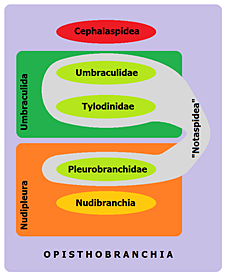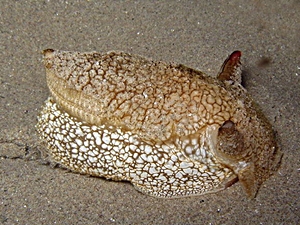
The former suborder Notaspidea and its distri-
bution on new clades. [RN]
After Bouchet et al. (2005).
 The former suborder Notaspidea and its distri- bution on new clades. [RN] After Bouchet et al. (2005). |
In the systematics according to Bouchet et al. (2005) the nudibranchs together with a family of side-gill slugs ('Notaspidea') make the clade Nudipleura. On this occasion, the 'Notaspidea' was disbanded for phylogenetic reasons.
 Pleurobranchaea meckelii from the Mediterranean and the At- lantic is a side-gill slug ('Notaspidea'). Well visible: The gill at the slug's right side. Picture: Stéphane Jamme (Source). |
 Umbrella shell (Umbraculum umbraculum) from Australia. Picture: David Harasti (Source). |
Some of the Pleurobranchomorpha belonging to the Nudipleura clade can produce acids as defence against predators.
So the species Berthellina citrina possesses many small mantle glands secreting a fluid containing sulphuric acid. Against the first assumption the slug at least acquires components of the acid from its food, we know today that the slugs produced all of it alone, independent from the food. The acid glands obviously do not help Berthellina against its own kind - the species (also) is a cannibal.
Pleurobranchaea maculata, up to 10 cm long, has become famous from New Zealand and Australia, because it contains the highly toxic tetrodoxin (TTX), a poison also found in puffer fish (Tetraodontidae) and blue ringed octopuses. However, tetrodoxin is not a poison the slug can produce itself, it has to acquire symbiotic bacteria from its food.
Pleurobranchaea maculata mainly feeds on sea anemones (Actiniaria). Those ingest bacteria containing TTX with their food. In the organism of slugs feeding on the anemones, the toxin finally accumulates. It remains unclear, if Pleurobranchaea maculata always contain TTX, or whether this is a regional phenomenon.
Like Berthellina, Pleurobranchaea also possesses acid glands. On its mantle, a ph value of 2 has been measured, about as much as lemon juice.
Two further families have been joined to a separate clade, Umbraculida, because they most likely evolved from a common ancestor together with the head-shield snails (Cephalaspidea) (see schematic).
The very widely distributed umbrella shell (Umbraculum umbraculum) is known from Africa and the Mediterranean, from Hawaii and Mexico, from New Zealand and Australia. In contrary to the Pleurobranchomorpha mentioned above, umbrella shells still have an external shell, to which they owe their name.